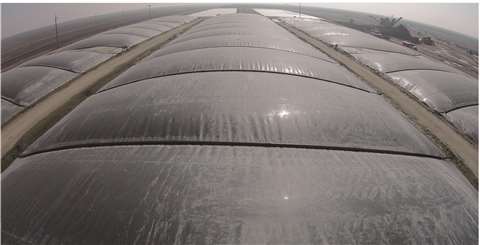Biogas part of a rapidly-evolving industry
29 November 2021
 Methane lagoon from Maas Energy Works
Methane lagoon from Maas Energy Works
A relatively new industry, biogas, has moved from infancy to adolescence within the U.S., and is rapidly evolving. The industry takes cow manure from local dairy farms and places it into covered lagoon digesters or similar digester vessels, where it naturally breaks down, releasing methane, carbon dioxide, hydrogen sulfide and other gases.
Maas Energy Works develops the digesters and works with dairy farms to produce and capture the gas. A 3500 cow dairy farm will produce on average 172,000 cubic feet of methane daily. The company has 29 digesters online and over 50 more in development across the U.S., said Doug Bryant, Maas communications director.
Although the digesters can have multiple designs, the climate in California, where many dairy farms produce biogas, allows for a relatively simple construction. The digester takes an existing manure pond (or digs a new one) and puts a tarp over it.
The oxygen-free environment allows the feedstock to digest and produce methane. The advantage to covered lagoon digesters is that they can easily be repaired and internal build up can be agitated and removed without major reconstruction.
The unprocessed gas is roughly 65% methane, 30% CO2, with some sulfur, oxygen and nitrogen. It is similar to fossil fuel natural gas but has higher moisture and higher CO2 content. Once the moisture, sulphur and CO2 have been scrubbed out, it can be injected straight into the common carrier gas utility pipeline or compressed and loaded onto tankers to be injected elsewhere.
To clean the gas, it is processed in multiple stages. The high moisture and sulphur content can be rough on a compressor or an engine so that is scrubbed and removed initially. The next step is to compress the gas with screw compressors and push through a membrane, which filters out the CO2.
The gas will need to be chilled once more to remove any remaining moisture and will then be compressed a second time via reciprocating compressors to utility pipeline pressure for injection or to even higher pressures for loading into a tanker.
The biogas can have multiple uses. In some cases, it is used to generate electricity which can supply all or part of the farm’s electricity needs. Any excess can be sold back into the electrical utility. The most common use in the industry currently is to compress the gas and create Renewable Compressed Natural Gas (R-CNG) and use it as fuel for cars and trucks.
This application has two separate effects on the environment: it reduces emissions of dairy farms and allows vehicles to use CNG, which burns cleaner than diesel.
In some cases, dairy farms that are within a 10-mile area can install gathering lines between all of the digesters to move unprocessed gas to a centralized processing facility, where it is upgraded to pipeline quality gas.
Maas Energy Works has a flexible business model that allows a dairy farmer to profit from the gas production in one of two ways. The first is to let the dairy owner finance the construction of the digester, gathering equipment and processing equipment up front. In those cases, the dairy farm retains ownership of all of the equipment and the gas and pays a fee to Maas Energy Works to develop and operate the facility.
In other cases, Maas Energy Works will finance the construction of the equipment. Maas Energy will then pay a fee to the dairy farm for their manure provided to the digester but will take ownership of the gas produced. Most of the value of the gas comes in the form of Avoided Methane Emission Credits, most preferably Low Carbon Fuel Standard (LCFS) credits that are generated when the biogas is converted to a vehicle fuel for use in California.
The industry itself is still young. Maas Energy Works was founded in 2010. The technologies that pressure and process biogas are still evolving and new players are coming in on a regular basis. “We’re still experimenting a bit to find our preferred technology,” he said.
The volumes of gas produced from digesters will likely not completely replace hydrocarbon gas anytime in the near future. “This is a significant dent in the supply though,” he said.
Biogas digesters are all over the country, including, Arizona, Texas, Wisconsin, Michigan, Colorado, Oregon, Washington and Idaho, but the technologies used in them vary by region. California has an ideal climate that does not require any added heat to produce the gas. In other areas, the digester has to be agitated and heated, which means more up front capital costs and higher costs of operation.
Although biogas digesters in California do not generally use added heat, their production climbs in the summer and falls off in the winter as the climate cools. In areas of the country where digesters are warmed, their production is more uniform throughout the year.
STAY CONNECTED




Receive the information you need when you need it through our world-leading magazines, newsletters and daily briefings.
POWER SOURCING GUIDE
The trusted reference and buyer’s guide for 83 years
The original “desktop search engine,” guiding nearly 10,000 users in more than 90 countries it is the primary reference for specifications and details on all the components that go into engine systems.
Visit Now
CONNECT WITH THE TEAM









